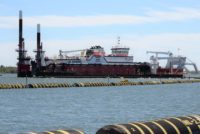The U.S. Army Corps of Engineers is raising the height of an emergency barrier sill by 25 ft to slow progression of a wedge of saltwater creeping up the Mississippi River from the Gulf of Mexico, which could render local water supplies in New Orleans undrinkable by the end of November.
Saltwater wedges are a naturally occurring phenomenon but have become more common with low-water levels caused by climate change-related drought. Last year, the Corps successfully halted the progression of a similar wedge with an underwater barrier built near Myrtle Grove, La.
While salt wedges are not new to southern Louisiana, state and Corps officials said this year’s wedge is the worst in decades. A saltwater wedge in 1988 reached as far as Kenner, La. This one could reach New Orleans’s Garden District by the end of October, according to estimates from the Corps.
The Corps completed construction of a new emergency sill near Naomi, La., in July 2023, but that structure was overtopped September 20 due to historically low water levels in the Mississippi River. Corps officials say they are using silt and debris to raise the sill from a depth of 55 ft to 30 ft below the river's surface to buy more time to halt the wedge. Construction began Sept. 25 and expected to take 24 days to complete.
The higher sill is expected to protect water supplies for 10 to 15 days, said Corps Spokesperson Matt Rowe, adding the river normally flows at 300,000 cu ft per second, but now is 140,000 cu ft per second.
Freshwater Deliveries
In addition to the sill augmentation, the Corps is preparing to transport fresh water to impacted areas. During previous low-water events, such as in 1988 and 2012, barging was used to transport fresh water to treatment facilities downriver of the saltwater toe.
“The Corps is securing water barges that will support impacted water treatment facilities by transporting water collected from portions of the river that do not have salinity readings,” said Col. Cullen Jones, Corps New Orleans District commander, in a statement. “This water can then be combined with water at the municipal facility to create a mixture that is safe for treatment.”
The first river barge carrying 500,000 gallons of fresh water arrived at the Port Sulphur Water Treatment facility in Plaquemines Parish, La., on Oct. 1. The delivery will be mixed with water at the intake facility to dilute salt content into safe drinking-water levels, according to the Corps.
Local water treatment facilities have been unable to treat high-salinity water as the salt is corrosive to the pipes. Two water treatment facilities were impacted by the saltwater wedge, Boothville and Port Sulphur, both in Plaquemines Parish. A spokesperson for the Parish’s Homeland Security/Emergency Management told ENR that Boothville went back online Sept. 29 after delivery of reverse osmoses equipment, which removes salt, grit, and dirt from water.
The Corps anticipates delivering water to the Port Sulphur and Pointe à La Hache facilities the second week of October. “The amount of water barged daily will depend on the amount required by a requesting facility at any given time. USACE is currently acquiring the capability of delivering 36 million gallons of water per day in the event additional facilities are impacted by the saltwater intrusion in the Mississippi River,” the Corps said in a statement.
For community leaders, the saltwater wedge is posing many questions, with few answers. “The biggest question right now is that there are a lot of unknowns. We just don’t know,” said Scott Walker, a Jefferson Parish Commissioners, which is expected to see the saltwater wedge creep into it by the end of the month.
“Jefferson Parish will be impacted in some way, shape or form, but how much is the big question,” he added.




Post a comment to this article
Report Abusive Comment